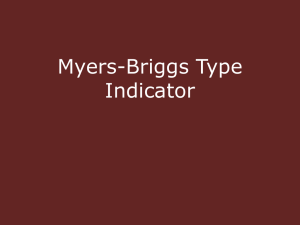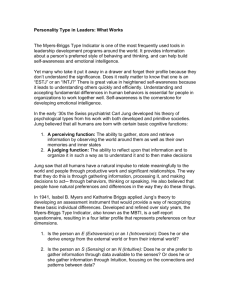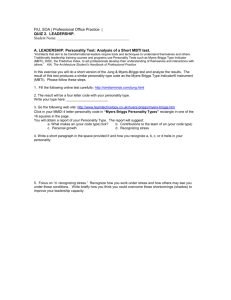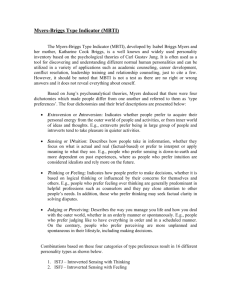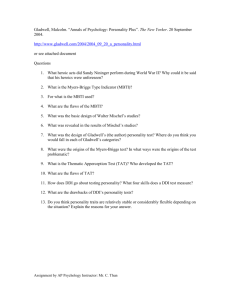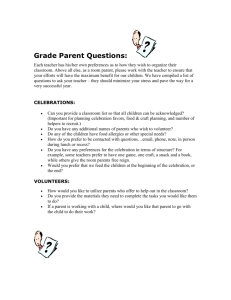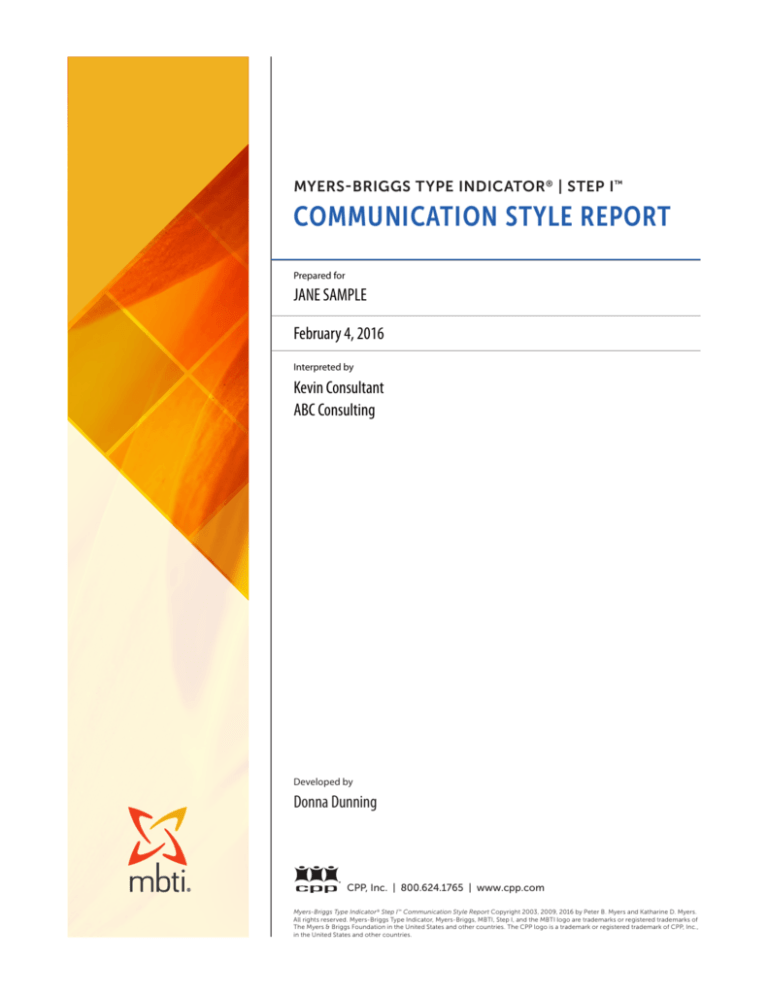
MYERS-BRIGGS TYPE INDICATOR® | STEP I™
COMMUNICATION STYLE REPORT
Prepared for
JANE SAMPLE
February 4, 2016
Interpreted by
Kevin Consultant
ABC Consulting
Developed by
Donna Dunning
CPP, Inc. | 800.624.1765 | www.cpp.com
Myers-Briggs Type Indicator ® Step I ™ Communication Style Report Copyright 2003, 2009, 2016 by Peter B. Myers and Katharine D. Myers.
All rights reserved. Myers-Briggs Type Indicator, Myers-Briggs, MBTI, Step I, and the MBTI logo are trademarks or registered trademarks of
The Myers & Briggs Foundation in the United States and other countries. The CPP logo is a trademark or registered trademark of CPP, Inc.,
in the United States and other countries.
COMMUNICATION STYLE REPORT
JANE SAMPLE
MYERS-BRIGGS TYPE INDICATOR ® | STEP I ™
ENFP | 2
About Your Report
You communicate with others every day. You may not always
take the time, though, to think about how your natural
communication style affects others. Your Myers-Briggs®
Communication Style Report is designed to help you become
aware of some important differences in communication styles.
The MBTI® assessment was developed by Isabel Briggs Myers and her mother,
Katharine Cook Briggs, based on the personality type theory proposed by
psychologist Carl Jung. The assessment identifies which of 16 different
personality types best describes you. Personality type is a nonjudgmental tool
for understanding the strengths and gifts of individuals. All personality types
are equally valuable and useful.
This report can help you
• Understand more about your Myers-Briggs personality type preferences
• Learn about and appreciate your natural communication style and the
influence your personality type has on it
• Learn strategies for adapting your style to communicate effectively with
others
HOW YOUR REPORT
IS ORGANIZED
Your MBTI type indicates which preference you favor in each of four pairs of
opposites.
EXTRAVERSION
or
INTROVERSION
Opposite ways to
direct and receive energy
SENSING
or
INTUITION
Opposite ways to
take in information
• Extraversion and Introversion in
Communication
THINKING
or
FEELING
Opposite ways to decide and
come to conclusions
• Sensing and Intuition in
Communication
JUDGING
or
PERCEIVING
Opposite ways to
approach the outside world
• Your Myers-Briggs® Personality
Type
• Clarity of Your Preferences
• Thinking and Feeling in
Communication
Keep in mind that this report describes your natural preferences, not your
• Judging and Perceiving in
Communication
learned skills or abilities. Everyone can learn to use all of the preferences to
• Your Communication Style
how people with your preferences tend to communicate. These descriptions
• Communication Tips for Your
Personality Type
aren’t intended to limit you; they’re meant to help you recognize your natural
communicate effectively. Your report gives you general descriptions about
style and see how your communication style differs from others.
COMMUNICATION STYLE REPORT
JANE SAMPLE
MYERS-BRIGGS TYPE INDICATOR ® | STEP I ™
ENFP | 3
Your Myers-Briggs® Personality Type
Your answers to the questions on the MBTI assessment show
which preference in each of the four pairs of opposites you
prefer.
Your reported Myers-Briggs personality type
ENFP
Your preferences
Extraversion | Intuition | Feeling | Perceiving
Although each of us can and does use all of the preferences at least some of the time, people typically find one in each
pair more comfortable and natural than its opposite. Think of your choices as something like being right- or left-handed.
Both hands are valuable and useful, but most people use the hand they favor naturally more often and become more
adept with it. In the same way, your type preferences are choices between equally valuable and useful qualities. Your ENFP
results are described below.
THE WAY YOU DIRECT AND RECEIVE ENERGY
Extraversion
People who prefer Extraversion tend to
direct their energy toward the outside
world and get energized by interacting with
people and taking action.
Introversion
People who prefer Introversion tend to
direct their energy toward their inner world
and get energized by reflecting on their
ideas and experiences.
THE WAY YOU TAKE IN INFORMATION
Sensing
People who prefer Sensing tend to take in
information that is real and tangible.
They focus mainly on what they perceive
using the five senses.
Intuition
People who prefer Intuition tend to take
in information by seeing the big picture.
They focus mainly on the patterns and
interrelationships they perceive.
THE WAY YOU DECIDE AND COME TO CONCLUSIONS
Thinking
People who prefer Thinking typically base
their decisions and conclusions on logic,
with accuracy and objective truth
the primary goals.
Feeling
People who prefer Feeling typically base
their decisions and conclusions on personal
and social values, with understanding and
harmony the primary goals.
THE WAY YOU APPROACH THE OUTSIDE WORLD
Judging
People who prefer Judging typically
come to conclusions quickly and want to
move on, and take an organized,
planned approach to the world.
Perceiving
People who prefer Perceiving typically
look for more information before coming
to conclusions and take a spontaneous,
flexible approach to the world.
COMMUNICATION STYLE REPORT
JANE SAMPLE
MYERS-BRIGGS TYPE INDICATOR ® | STEP I ™
ENFP | 4
Clarity of Your Preferences
Your MBTI responses also provide a picture of how clearly or consistently you chose your preference in each pair of
opposites. This preference clarity index (pci) is indicated in the graph below. A longer line suggests that you are quite sure
about a preference; a shorter line means that you are less sure about whether that preference truly describes you. Your
preference clarity does not indicate how well developed your preferences are or how well you use them.
CLARITY OF YOUR PREFERENCES: ENFP
VERY
CLEAR
EXTRAVERSION
e
SENSING
s
THINKING
t
JUDGING
j
MODERATE
SLIGHT
MODERATE
CLEAR
VERY
CLEAR
•
I
•
FEELING
•
25
20
15
EXTRAVERSION | 26
10
5
INTUITION | 26
0
INTROVERSION
INTUITION
•
30
PCI RESULTS:
CLEAR
5
10
FEELING | 3
15
20
25
PERCEIVING
30
PERCEIVING | 25
Do your assessment results seem to fit? Many find that their type results capture their personality attributes quite well.
Others find that changing one or more of the preferences in their four-letter type yields a type description that fits them
better. Your results can be influenced by circumstances, experiences, demands, and expectations you were feeling when
you took the assessment. If your reported type does not seem to fit, work with your Myers-Briggs practitioner, who can
assist you in finding the type that fits you best.
COMMUNICATION STYLE REPORT
JANE SAMPLE
MYERS-BRIGGS TYPE INDICATOR ® | STEP I ™
ENFP | 5
Extraversion and Introversion in Communication
Let’s talk this over.
You prefer Extraversion over Introversion.
EXTRAVERSION
Your Key Strengths
Are active, energetic, and enthusiastic
Think on your feet
Establish networks of contacts
Have a broad range of interests
Provide extensive information and feedback
Your Communication Approach
Seek interactions and diversions
Share thoughts freely in lively group discussions
Can discuss a wide range of topics
Change topics and opinions as a conversation progresses
Think out loud
Share ideas or information immediately
Respond rapidly
Talk more than listen
Interrupt and may finish other people’s sentences
Ask lots of spur-of-the-moment questions
Tips for Communicating with Introverts
Let them finish their thoughts; don’t interrupt them
Think before speaking or let them know that you are thinking out loud
Respect their need for privacy, build trust, and ensure confidentiality
Choose a time and place to communicate with a minimum of distraction
Speak slowly and calmly (without being condescending)
Pause and wait for a response; don’t jump in to fill silence, especially with
small talk
Have one-to-one conversations rather than communicating in a group setting
Don’t come across as imposing or demanding an immediate response
Provide information ahead of time and allow time and space for processing
When possible, provide written information that they can consider in their
own time
COMMUNICATION STYLE REPORT
JANE SAMPLE
MYERS-BRIGGS TYPE INDICATOR ® | STEP I ™
ENFP | 6
Sensing and Intuition in Communication
I can see it all now.
You prefer Intuition over Sensing.
INTUITION
Your Key Strengths
Are open to possibilities
Anticipate and create change
Are future oriented; see trends
Link and integrate information
Generate ideas
Your Communication Approach
Want to know implications and relationships, not just facts
Become bored or impatient with details
Like to brainstorm or play with ideas and imagine what could be
Focus on the future and long-term aspects and effects
See patterns and understand the big picture
Are stimulated by possibilities; seek to create, grasp, and share new ideas
Use metaphors, analogies, and other forms of symbolic language
In conversations, may jump across topics exploring links
Trust and are eager to apply theories, models, and frameworks
Don’t like to be hampered by barriers or limits
Tips for Communicating with Sensing Types
Be practical and find ways to bring ideas down to earth
Talk about how to immediately apply information
Provide concrete examples to prove that your ideas work
Share your observations and experiences
Present information sequentially and include relevant facts and details
Show a plan and a procedure when initiating change
Link new ideas to what is happening now
Focus on and preserve what is working well
Avoid extensive use of metaphors and analogies
Use words that relate to sensory and real-life images
COMMUNICATION STYLE REPORT
JANE SAMPLE
MYERS-BRIGGS TYPE INDICATOR ® | STEP I ™
ENFP | 7
Thinking and Feeling in Communication
Will anyone be hurt?
You prefer Feeling over Thinking.
FEELING
Your Key Strengths
Empathize and develop rapport
Can often see and appreciate others’ perspectives
Are supportive, nurturing, and interested in others
Enjoy cooperating and collaborating
Connect with others and create a harmonious environment
Your Communication Approach
Focus on situational and subjective beliefs and values
See strengths and positive attributes
Enjoy encouragement and positive feedback
Share personal situations, case histories, stories, and examples
Want to get to know someone personally
Like making links to and connections with others
Like collaboration and want to cooperate
Are warm, supportive, expressive, and affirming
Focus on positive atmosphere and harmony
Are interested in people and their needs
Tips for Communicating with Thinking Types
Be calmly objective and demonstrate your competence
Offer honest and frank corrective feedback as well as positive comments
Detach from situations and view them logically and objectively
Support your opinions with logical reasoning and clear thinking
Avoid becoming emotional or passionate when discussing issues
Be straightforward, reasonable, clear, precise, and concise
Focus on tasks and objectives as well as on individuals involved in the situation
Be prepared to sometimes engage in competitions, debates, or challenges
Show cause-and-effect relationships and pros and cons
Provide data and ideas only from credible information sources
COMMUNICATION STYLE REPORT
JANE SAMPLE
MYERS-BRIGGS TYPE INDICATOR ® | STEP I ™
ENFP | 8
Judging and Perceiving in Communication
Let’s wait and see.
You prefer Perceiving over Judging.
PERCEIVING
Your Key Strengths
Are flexible and adaptable
Respond to the situation as needed
Are open to new information
Generate and consider a wide range of options
Take an easygoing approach to change
Your Communication Approach
Seek new information and explore options
Include lots of data and ideas in the decision-making process
Have a flexible, spontaneous, and unstructured communication style
Are open to responding to unexpected requests or opportunities
Can postpone decisions or make tentative decisions that can change
Seek input from others exactly when you need it
Feel boxed in if immediate decisions are requested
Ask questions and provide options
Prefer open-ended discussions and language to conclusive statements
See opportunity in interruptions and diversions
Tips for Communicating with Judging Types
Set and follow a schedule
Offer conclusions and your rationale to facilitate decision making
Be willing to make a decision and move forward
Share information in a structured and organized way
Avoid sharing too many open-ended options; focus on what is most important
Negotiate specific time lines and deadlines
Consistently meet commitments; show up on time and deliver results
Provide clear roles and expectations when assigning tasks
Make and follow through with plans
Avoid adding unexpected tasks or options to a project, especially at the last minute
COMMUNICATION STYLE REPORT
JANE SAMPLE
MYERS-BRIGGS TYPE INDICATOR ® | STEP I ™
ENFP | 9
Your Communication Style
ENFP Communication Highlights
Are outgoing, optimistic, caring, genuine, and compassionate
IMAGINATIVE
MOTIVATOR
Energetically and enthusiastically encourage and persuade others
Identify opportunities to develop human potential and improve people’s situations
Champion changes that provide possibilities and improve processes for people
Help people find niches, develop strengths, and compensate for weaknesses
At First Glance
Empower, advocate for, and encourage the individual in the organization
Enjoy collaboration, cooperation, and the sharing of ideas
See potential and possibilities in people; focus on relationships and growth
Create and share a wealth of innovative ideas and a vision of the future
Value and encourage diversity; enjoy working with a wide variety of people
What You Want to Hear
People’s experiences, feelings, thoughts, viewpoints, and ideas
Conversations showing that people are interested in getting to know each other
and developing relationships
General guidelines and information, not specific directions or commands
Theories and models that will enhance growth, learning, and development
Collaborative language focusing on teamwork and individual contributions
When Expressing Yourself
Are highly participative, sociable, and friendly; connect and develop rapport with
others
Use empathy when interpreting situations and dealing with others
Are sensitive to group dynamics; highlight and integrate ideas and input
Often teach, counsel, facilitate, motivate, negotiate, recruit, and resolve conflicts
Challenge accepted practices if not aligned with human values or needs
Giving and Receiving Feedback
Validate, appreciate, and celebrate unique and valuable individual contributions
Seek to please others; motivated by positive feedback and encouragement
Like to be mentored or supported within the work setting rather than supervised
Are sensitive to, and can be hurt by, feedback that is objective and task focused
rather than personal
Will give more positive than corrective feedback and may hesitate to criticize
others
COMMUNICATION STYLE REPORT
MYERS-BRIGGS TYPE INDICATOR ® | STEP I ™
JANE SAMPLE
ENFP | 10
Communication Tips for ENFPs
Here are some strategies to help you adapt your natural way of communicating to accommodate people with different
personality types.
• Some people can see personal involvement as interference rather than encouragement. Learn when to back off from
discussing personal matters to avoid being seen as intrusive or not businesslike.
• To ensure that you don’t lose sight of the task at hand, avoid becoming distracted by people’s stories and needs.
• Be practical and logical as well as personal and inspired. Make sure your ideas are grounded and realistic. Others will
need to see the logic and details underlying your innovative ideas.
• Remember that not all people are motivated by the concept of personal growth. Show how personal development
links to developing competencies, enhancing performance, and affecting business results.
• Some people distrust highly energetic and enthusiastic persuasion. Be willing to tone down the pace and energy level
when you present information and ideas to people who are more reserved, quiet, or skeptical.
• Be open to giving and receiving constructive feedback and see this as an opportunity for growth. Be careful not to
take feedback personally.
• It may be easy for you to change course and leave projects undone. This can irritate those who are strongly task and
deadline oriented. As well as conceptualizing and implementing ideas, be sure to follow through and finish tasks.
Next Steps for Improving Your Communication
• Highlight the statements on the previous pages that most accurately describe you. Consider how your
communication preferences affect your day-to-day interactions in positive ways and how your preferences may
affect your interactions in negative ways.
• Review the suggestions for communicating with people who have a preference different from yours. Choose one or
two tips to try first. After using the tip(s), assess whether the change has improved your communication.
• Review the tips for communication tailored to your personality type. Try one out. Track your progress by assessing
whether the change was helpful.
• Learn about type dynamics, a theory that offers a deeper look into your communication style. Type dynamics can
help you understand why and how you typically communicate and how your communication style may change
when you are stressed.
• Discuss type development with the professional who recommended the MBTI assessment to you. Type development
provides insights into how and why your communication style may evolve as you age.
CPP, Inc. | 800.624.1765 | www.cpp.com |
© Full copyright information appears on page 1.

